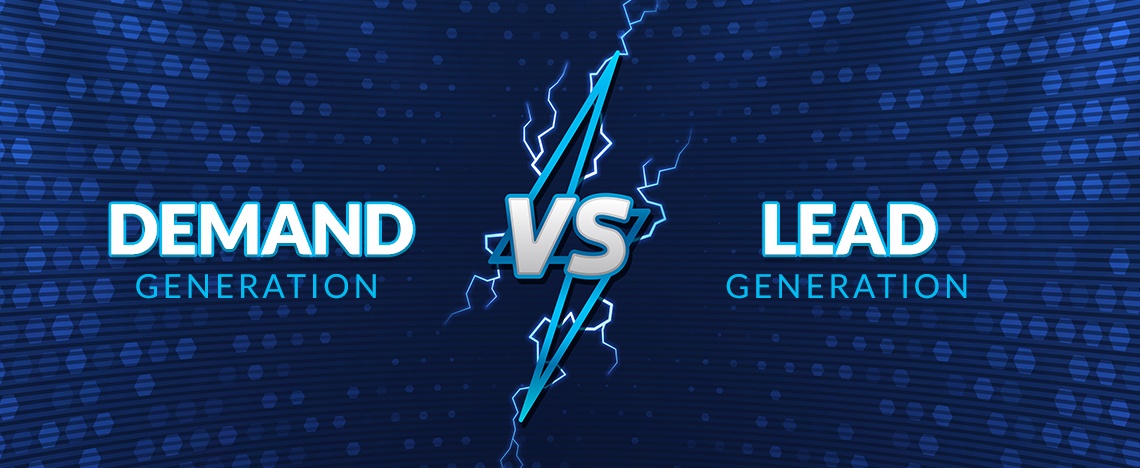
Demand Generation vs. Lead Generation: What’s the Difference & When to Use Each

In 2007, Steve Jobs stood on stage at an Apple event and introduced the iPhone. The device, which was touted as “a revolutionary mobile phone, a widescreen iPod® with touch controls, and a breakthrough Internet communications device with desktop-class email, web browsing, searching and maps,” was shown to a public who was used to using simple, flip phones. The audience didn’t know how to react to this new device they didn’t know they needed.
Apple’s announcement on that day was a form of demand generation—generating interest and creating demand—for the newly minted iPhone, which continued as the device evolved.
While creating demand for a product might seem easy for a well-known brand like Apple, most marketers struggle to reach potential customers in this fragmented digital world. According to the Content Marketing Institute, 58 percent of marketers surveyed reported their demand generation efforts were successful, while only 18 percent reported their efforts were very successful.
By contrast, customer service software firm IntelliResponse wanted to improve its lead generation efforts. The company struggled with two issues: It had a technology businesses didn’t know they needed and, if companies were using the technology, they struggled with realizing its full benefits.
To improve lead generation and remedy these knowledge gaps, IntelliResponse created content marketing campaigns featuring case studies and thought leadership focusing on two issues: common customer service issues prospects might experience and how IntelliResponse’s software could help. The company promoted the new content with LinkedIn advertising and on its social media channels, which saw a 100 percent increase in new leads and a 400 percent increase in site traffic.
Lead generation and demand generation may sound very similar, but there are important differences between the two. To help you get the most out of your marketing efforts, let’s look at the role demand generation and lead generation play in your strategy and how you can effectively use each.
Demand Generation vs. Lead Generation: What is the Difference?
Demand generation and lead generation: They’re basically the same, right? Though the terms are often used interchangeably by marketers, they are quite different. So, what is lead generation and demand generation, and when should they be used? Let’s find out.
While the purpose of demand generation and lead generation are the same—to make people want to buy from you—and both heavily rely on solid content to be successful, the interim results differ.
Demand generation refers to the marketing initiatives that create interest in your product or service. These programs help your company reach new markets, generate PR, build buzz and re-engage existing customers. To put it simply, as its name suggests, demand generation makes people want to buy from you by creating demand.
But demand generation doesn’t stop there. In addition to creating a demand for your product or service, it is used to build and nurture prospects and customers over the long term.
Lead generation refers to the collection of consumer information—an email address, a phone number, etc.—to turn consumers into sales leads.
While lead generation works to turn prospects into leads, demand generation works to keep your sales pipeline full. They can, of course, be used together. Think of it this way: Lead generation lets you know the success of the demand you are creating.
According to HubSpot, 63 percent of marketers said generating traffic and leads was their top marketing challenge.
Demand Generation vs. Lead Generation: What Content Should I Use?
Ungated content is commonly used—with a call to action (CTA)—for demand generation efforts. Keep in mind, consumers are being introduced to your brand/website/services with demand generation, so you want to provide content that helps establish your expertise while sparking interest in your offerings. Content usually used for demand generation includes:
- Blog posts
- Infographics
- Videos
- Podcasts
- Case studies
- Press releases
- Articles
Gated, or more detailed content, is typically used for lead generation. Remember, this is the content you’re offering prospective leads, so it should be so valuable they’re willing to give up their contact information for access. Common examples of this type of content include:
- eBooks
- Whitepapers
- Panels
- Webinars
- Free trials
Demand Generation vs. Lead Generation: 4 Common Mistakes and how to Avoid Them
No. 1: Only Using Demand Generation at the Top of the Funnel
Eighty-seven percent of marketers reported they used demand generation at the early stages of the buyer’s journey to generate interest. As Robert Rose at Content Marketing Institute notes, it’s one thing to grab someone’s attention; but to be successful you’ve got to hold that person’s attention, which requires producing content for other stages of the journey as well. Consider pieces like white papers and case studies for the middle/later stages of the journey.
Interestingly, marketers noted in-person events like panels were equally effective across all stages of the buyer’s journey.
No. 2: Not Experimenting With Content Throughout the Buyer’s Journey
While case studies may be effective during the later stages of the buyer’s journey, they may also be effective at generating awareness during the beginning stages. It all depends on how the content is structured. An eBook, for example, might work well as an awareness piece if it outlines the implications of not changing or doing something. When you decide what piece to use when, don’t forget to test to see how it is performing.
No. 3: Not Having a Dedicated Demand Generation Department
Paid advertising can be an overlooked element of a successful demand and lead generation strategy. This is often because the amount of time it takes to gain momentum and manage it is underestimated. That’s where a dedicated demand generation department—or someone to manage and guide your paid advertising and SEO efforts—comes in.
A dedicated demand generation department can enhance your SEO efforts, connect you with the right audience and provide you with a multilevel approach to paid advertising. They will continuously test new channels and strategies, ensuring your company maintains a competitive edge online, among other benefits. Put simply, a dedicated demand generation department helps connect your brand with the right people in a timely manner.
No. 4: Not Having a Straightforward Conversion Process
Do you get frustrated if a site takes too long to load or a form asks for too much information? If you feel irritated by these minor inconveniences, chances are your customers will, too. Make the process as smooth as possible and reduce the possibility of missed conversions by:
- Minimizing distractions
- Having one conversion point per landing page or email
- Making sure the page loads within a few seconds
- Designing the page for the user experience
Using data from HubSpot and sites like Crazy Egg and Hotjar can help you see where site visitors go and how they interact with your site.
Demand Generation vs. Lead Generation: They Should Work Together
We’ve spent the majority of this post breaking down the differences between demand generation vs. lead generation, but to be successful with either, you need to stop looking at the two tactics as competitors. Success depends on how well demand generation and lead generation work together.
When we think about demand generation vs. lead generation and when to use which, we’re often looking at metrics like site visits, page activity, engagement and quantity of leads. While this information is valuable and can help tailor your strategy, be willing to experiment with what type of content you use and when/where you use it.
Building an audience around a particular topic, Rose asserts, is oftentimes more valuable to a brand than simply creating a one-off campaign with the sole purpose of collecting leads or generating buzz. Some of the content you create for your audiences will result in leads; however, most won’t, and that’s okay. Your audience can still provide value to you by:
- Informing you where you should market next
- Sharing your content and amplifying your reach, possibly exposing you to hard to reach buyers
- Increasing brand awareness
How to Use Demand Generation and Lead Generation: A Real-World Example
A lawn care company struggled to bring in new business using traditional marketing tactics, so the company sought a better lawn care marketing plan to reach new customers and secure “Request a Quote” conversions.
To create demand and capture leads, Kuno helped the company take a targeted approach to PPC and Facebook advertising. The Kuno team targeted phrases and keywords that were symptom-based for lawn care, like crabgrass.
In one month, this new approach netted the company 1,245 conversions/leads to request a quote and 865 calls to request a quote using a special 800 number that was placed in the ads.
By using your content to fuel your demand generation initiatives, you can create audiences that will provide you with valuable insight.
While the terms might sound similar, lead generation and demand generation are two separate strategies. Each, however, plays an integral role in the success of your marketing. Knowing the right strategy to use and when to use it can make all the difference.





